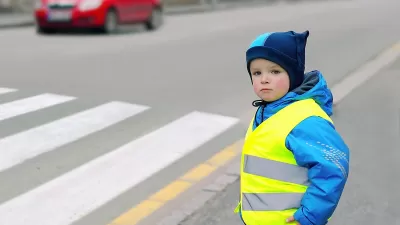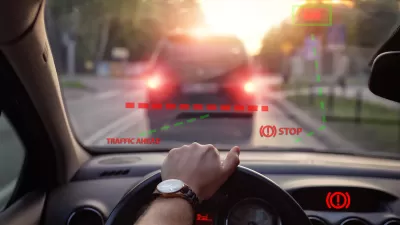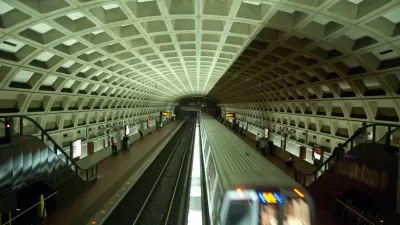Two commuter trains traveling toward each other on a single track crashed in the Puglia region of southern Italy on Tuesday morning. Human error is suspected. The trains and track lacked automatic train control and automatic braking.
Total fatalities won't be determined until a crane can pull the cars apart. Other media outlets report that 23, not 25, had died. Forty-three people were injured. Each train had four passenger cars, but only one rail car was left standing. The trains were estimated to have been traveling at 56 m.p.h. at the time of impact.
The BBC video shows an aerial sight of the crash. It's difficult to even detect some of the rail cars among the wreckage.
"Prime Minister Matteo Renzi sent the infrastructure and transportation minister, Graziano Delrio, and the head of the civil protection agency, Fabrizio Curcio, who oversees emergency response in Italy, to the site of the crash," reports Gaia Pianigiani from Rome for The New York Times.
The circumstances that led to the collision were unclear. A team of inspectors from the transportation ministry will work with local prosecutors to determine the cause, officials said.
Lack of automatic braking or automatic train control
Stefania Gnesi, an information technology staff researcher at the National Research Council, said that the trains were probably operating on instructions from dispatchers. “It’s probable that there was some human error in this chain, in a section of train track that has no automatic control or automatic brake system,” she said.
Automatic systems are used on most of Italy’s railway lines, but have not yet been installed in some areas, especially in southern Italy, which is less developed and less prosperous than the north.
The crash is the most deadly since June 2009 when a 14-car freight train carrying liquefied petroleum gas derailed and exploded near Tuscany, ultimately killing 32 people.
Deadly Amtrak derailment in May 2015
Similar issues regarding automatic braking were raised in a May 2015 Amtrak derailment in Philadelphia that left eight dead.. The Federal Railroad Administration ordered Amtrak to install automatic train control on northbound trains in the Northeast Corridor that is already working for southbound trains, notes a later post.
According to CNN, "(t)he system notifies an engineer if a train is speeding and applies the brakes automatically if the engineer does not respond. Amtrak is in the process of installing a sharper technology known as Positive Train Control (PTC) on all of its tracks."
The National Transportation Safety Board determined a year after the derailment that human error was the cause of the derailment, specifically resulting from the "loss of situational awareness by the train’s engineer after his attention was diverted to an emergency involving another train."
Head-on crash in Germany in February
A similar head-on crash on a single track occurred on February 9 in Germany, leaving 10 dead. Human error was to blame. After an investigation, it was determined that the dispatcher was "playing a game on his cellphone until just before the accident," reported Alison Smale for The New York Times in April. Unlike the Italian crash, the trains and track were fitted with automatic braking.
That crash raised "new questions about the safety and reliability of a rail network in Europe that has been the envy of much of the world, reported Melissa Eddy for The New York Times in February, adding that "crashes across Europe in recent years have highlighted weaknesses in the rail network." Eddy later wrote that "the German news media have reported that the [automatic braking] system had been turned off at the time of the crash."
FULL STORY: Train Crash in Italy Leaves at Least 25 Dead and Dozens Injured

Alabama: Trump Terminates Settlements for Black Communities Harmed By Raw Sewage
Trump deemed the landmark civil rights agreement “illegal DEI and environmental justice policy.”

Study: Maui’s Plan to Convert Vacation Rentals to Long-Term Housing Could Cause Nearly $1 Billion Economic Loss
The plan would reduce visitor accommodation by 25% resulting in 1,900 jobs lost.

Planetizen Federal Action Tracker
A weekly monitor of how Trump’s orders and actions are impacting planners and planning in America.

Wind Energy on the Rise Despite Federal Policy Reversal
The Trump administration is revoking federal support for renewable energy, but demand for new projects continues unabated.

Passengers Flock to Caltrain After Electrification
The new electric trains are running faster and more reliably, leading to strong ridership growth on the Bay Area rail system.

Texas Churches Rally Behind ‘Yes in God’s Back Yard’ Legislation
Religious leaders want the state to reduce zoning regulations to streamline leasing church-owned land to housing developers.
Urban Design for Planners 1: Software Tools
This six-course series explores essential urban design concepts using open source software and equips planners with the tools they need to participate fully in the urban design process.
Planning for Universal Design
Learn the tools for implementing Universal Design in planning regulations.
Caltrans
Smith Gee Studio
Institute for Housing and Urban Development Studies (IHS)
City of Grandview
Harvard GSD Executive Education
Toledo-Lucas County Plan Commissions
Salt Lake City
NYU Wagner Graduate School of Public Service





























